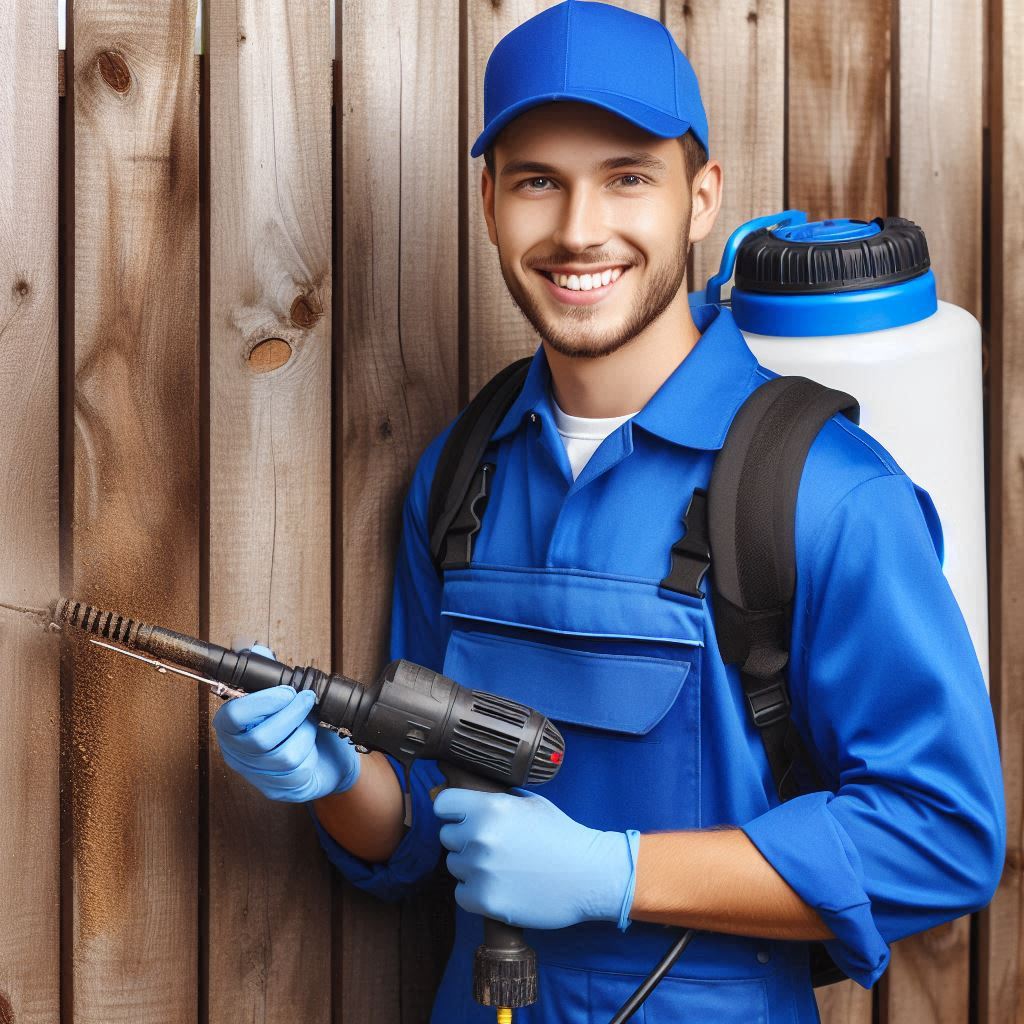Introduction
Pest control workers play a vital role in maintaining safe and healthy environments.
They manage infestations and prevent property damage caused by insects, rodents, and other pests.
By using specialized tools, they ensure their work is effective, efficient, and safe.
Pest control workers assess infestations, identify pests, and develop targeted treatment plans.
Their job requires precision and knowledge to handle dangerous chemicals and tools safely.
Whether they work for homes or businesses, their goal is to eliminate pests without harming people, pets, or property.
The tools pest control workers use make their jobs faster and more accurate.
Without the right tools, it‘s challenging to remove pests completely or safely.
These tools ensure they apply pesticides accurately, avoid contamination, and monitor results over time.
Proper tools also protect workers from exposure to chemicals and bites or stings from pests.
High-quality tools are essential for pest control workers to maintain public health and safety.
By using the correct equipment, they minimize the risk of recurring infestations, making their services effective.
Personal Protective Equipment (PPE)
Pest control workers use a variety of tools, but none are more important than personal protective equipment (PPE).
PPE serves as the first line of defense, shielding workers from harmful chemicals and pests.
The equipment prevents dangerous exposure, ensuring safety on the job.
PPE Used by Pest Control Workers
PPE for pest control professionals includes essential gear that protects against multiple hazards.
These items are carefully designed to cover and safeguard the body.
Each piece of equipment serves a specific purpose in reducing contact with chemicals and pests.
Pest control professionals often encounter harsh pesticides and biohazards, which require full body protection.
One key item is gloves, which shield hands from chemicals and direct contact with pests.
These gloves are typically made of durable materials, such as rubber or nitrile.
They prevent dangerous substances from penetrating the skin, keeping workers safe from irritation or absorption of toxic chemicals.
Another essential piece is the mask, which helps workers avoid inhaling harmful fumes.
Masks come in different types, but most pest control workers wear respirators.
These masks filter out toxic particles from the air, minimizing respiratory issues caused by chemical exposure.
Pest control workers wear coveralls to protect their entire body.
These suits are lightweight and provide full coverage from head to toe.
Some are even treated with special chemicals to repel pests or prevent contamination.
Coveralls prevent pests from crawling on workers and keep chemicals from absorbing through clothing.
Importance of Wearing PPE to Protect Against Chemicals and Pests
Wearing PPE is crucial for pest control workers to maintain their health and safety.
Exposure to hazardous chemicals, such as pesticides, can lead to severe health issues.
Prolonged contact with these chemicals may cause skin irritation, burns, or even long-term illnesses.
Without proper protective gear, pest control professionals risk serious injuries or health problems.
In addition to chemicals, pests themselves pose a danger.
Some pests carry harmful diseases, such as rodents spreading hantavirus or fleas carrying plague.
Direct contact with these pests could result in infection or bites, leading to further complications.
Wearing gloves, coveralls, and masks reduces the risk of exposure to these biological hazards.
Using PPE also ensures compliance with industry safety standards.
Pest control companies are required to follow strict safety regulations, and workers must use appropriate PPE during treatments.
By adhering to these guidelines, pest control workers protect themselves and the public from harmful substances.
Examples of PPE Used in Pest Control
Common examples of PPE include gloves, masks, coveralls, goggles, and boots.
Workers wear these items every day to reduce risk during operations.
Gloves and masks are used to handle chemicals safely and avoid inhaling toxic fumes.
Coveralls offer full-body protection, while goggles shield the eyes from splashes or debris.
PPE is vital for pest control workers.
It ensures they can safely perform their duties while minimizing risk from chemicals and pests.
Sprayers
Pest control workers rely heavily on sprayers for the efficient application of pesticides.
Sprayers ensure that pest infestations are controlled with precision and effectiveness.
The choice of sprayer depends on the type of infestation and the area being treated.
Let’s explore the different types of sprayers and their crucial role in pest control.
Types of Sprayers Used in Pest Control
There are several types of sprayers commonly used by pest control professionals.
The most widely used include handheld sprayers, backpack sprayers, and power sprayers.
Each type serves a unique purpose and comes with specific advantages depending on the job’s requirements.
Handheld Sprayers
Handheld sprayers are ideal for small areas or targeted applications.
They are portable, easy to use, and require minimal setup.
These sprayers work best for spot treatments, making them suitable for small indoor infestations.
Their simplicity allows pest control workers to quickly apply pesticides in tight spaces.
Backpack Sprayers
Backpack sprayers are a step up in size and capacity.
They allow pest control workers to cover larger areas efficiently.
Worn on the back, these sprayers provide better mobility while maintaining control over pesticide application.
They are ideal for medium-sized outdoor or indoor areas, such as gardens, lawns, or large warehouses.
Power Sprayers
Power sprayers are the heavy-duty option.
These sprayers are motorized and can cover vast areas with minimal effort.
They are commonly used in large-scale pest control operations, such as farms, public parks, or industrial settings.
The power sprayer’s pressure and volume make it effective for wide-scale treatment of pests.
Importance of Sprayers in Pest Control
Sprayers are essential for the efficient and effective application of pesticides.
They ensure the chemicals are evenly distributed across the treatment area, maximizing their effectiveness.
Without sprayers, controlling pests would be labor-intensive and prone to inefficiency.
Sprayers also reduce the risk of human exposure to harmful chemicals by minimizing the need for manual handling.
Moreover, sprayers help pest control workers adjust the volume and pressure of the pesticide.
This control is critical to preventing over-application, which can harm non-target species and the environment.
The ability to tailor the application for different pest problems increases the success of the treatment.
Examples of Common Sprayers
Backpack sprayers and power sprayers are among the most popular tools used in the industry.
The backpack sprayer offers flexibility for mid-sized jobs while maintaining efficiency.
Power sprayers, on the other hand, excel in large-scale pest control where covering large areas quickly is essential.
Sprayers are indispensable tools in pest control.
Their variety allows professionals to choose the right tool for each task, ensuring precise pesticide application.
This efficiency helps pest control workers maintain a safe and effective working environment.
Read: Essential Skills Every Pet Groomer Should Have
Traps and Baits
Pest control workers rely heavily on traps and baits to manage and eliminate pests effectively.
These tools offer a non-invasive and targeted approach to capturing or eradicating various pests.
Traps and Baits Used to Capture and Eliminate Pests
Traps and baits come in various forms to capture or kill pests without extensive use of chemicals.
Pest control professionals strategically place traps to lure pests, using their natural behaviors to draw them in.
Some traps use physical mechanisms, while others rely on adhesive or poison to capture pests.
Baits, on the other hand, contain attractants that lure pests to consume toxic substances.
Rodent baits, for example, often include food elements mixed with slow-acting poisons.
These slow-acting baits allow rodents to return to their nests before dying, ensuring a broader reach within the pest population.
Bait stations help protect pets or children by securing the poison inside a tamper-proof container.
Glue traps are commonly used to catch smaller pests, such as insects and rodents.
They contain a strong adhesive that traps the pest upon contact.
The simplicity and effectiveness of glue traps make them ideal for early-stage infestations.
Importance of Using Traps and Baits for Monitoring and Control
Traps and baits serve more than just pest elimination; they also play a crucial role in monitoring.
By placing traps in strategic locations, pest control workers can assess pest populations and activity levels.
These insights guide the development of targeted control measures, reducing the need for widespread chemical treatments.
Traps offer real-time data, revealing where pests are most active.
This information allows pest control workers to focus on those areas, ensuring that treatment is precise and effective.
Monitoring traps also help detect new infestations before they become severe.
Baits, particularly slow-acting ones, help eradicate entire colonies or nests.
Pest control professionals can place bait stations in locations where pests frequent, ensuring maximum exposure to the poison.
As pests feed on the bait and return to their colonies, they inadvertently spread the poison, accelerating population control.
Examples of Traps and Baits: Glue Traps and Rodent Baits
Glue traps are commonly used for small insects and rodents.
These traps consist of a sticky surface that captures pests on contact.
Rodents and insects caught in glue traps cannot escape, leading to their eventual death.
Glue traps are ideal for indoor use and in sensitive areas where chemicals might be dangerous.
Rodent baits, like those used in bait stations, attract rodents with food and deliver a toxic dose.
These baits offer a discreet and highly effective way to control larger infestations.
Bait stations keep the poison contained, reducing risks to non-target animals and humans.
Traps and baits are indispensable tools in pest control.
They provide an efficient, targeted solution to monitor and eliminate pests without excessive chemical usage.
Read: How to Handle Emergency Situations in Pet Grooming
Transform Your Career Today
Unlock a personalized career strategy that drives real results. Get tailored advice and a roadmap designed just for you.
Start NowInspection Tools
Pest control workers rely heavily on inspection tools to detect and identify infestations.
These tools allow them to gather vital information about the pest situation in homes, businesses, and other properties.
Tools Used for Inspecting and Detecting Pests
Inspecting and detecting pests requires specialized tools to assess conditions effectively.
Every pest control professional uses inspection tools to search for signs of pests, such as droppings, nests, or damage.
These tools also help detect environmental factors like humidity or hidden cracks where pests can thrive.
Proper use of these inspection tools ensures an accurate diagnosis of the problem, leading to better pest control outcomes.
Without them, many pest issues would go unnoticed or untreated.
Importance of Thorough Inspections in Pest Control
Thorough inspections are crucial in pest control because they ensure no infestation goes undetected.
Missing even a small portion of an infestation can allow pests to multiply rapidly.
A thorough inspection lets pest control workers uncover hidden nests, entry points, and sources of food or water.
This helps in creating a more effective treatment plan.
It also ensures that future infestations are less likely to occur.
By conducting detailed inspections, professionals can target the root cause of a problem instead of just treating surface symptoms.
Regular inspections also prevent infestations from worsening.
Early detection can stop a small issue from becoming a full-blown infestation.
The earlier the detection, the easier and more cost-effective the treatment.
Inspections also provide critical data for pest control companies to track patterns over time.
This information can be used to modify treatment plans and improve the long-term management of pest issues.
Examples of Inspection Tools
Pest control professionals rely on several key tools during inspections.
Flashlights, magnifying glasses, and moisture meters are among the most commonly used.
Flashlights
A flashlight is essential for seeing in dark corners, under furniture, or in tight spaces.
Pests often hide in these areas, so having good visibility is crucial.
High-quality flashlights reveal signs of pest activity like droppings, stains, or nests.
Magnifying Glasses
Magnifying glasses help pest control workers closely inspect small areas for signs of insects.
This tool enhances their ability to spot tiny pests or eggs that may otherwise be missed.
Moisture Meters
Moisture meters measure the level of humidity in walls, floors, and ceilings.
Certain pests, like termites and mold mites, thrive in damp environments.
Using a moisture meter allows professionals to identify areas where moisture is present, indicating where pest activity is more likely to occur.
These inspection tools play a vital role in helping pest control workers accurately assess and address infestations.
They provide the precision and thoroughness needed to protect homes and businesses from pest problems.
Read: How Much Do Pet Groomers Earn in the USA?

Dust Applicators
Usage of Dust Applicators
Dust applicators are essential tools in pest control for applying insecticide dusts.
They provide a precise and controlled way to distribute insecticide dust into cracks, crevices, and other areas where pests hide.
These applicators come in various designs, each tailored to suit different types of infestations and environments.
Dust applicators typically have a chamber that holds the dust and a mechanism to release it in a fine, targeted manner.
When used correctly, these devices can penetrate deep into wall voids, attics, or behind large appliances, making them perfect for reaching pests in their most secure hiding spots.
Importance of Dust Applicators for Treating Hard-to-Reach Areas
In pest control, hard-to-reach areas can be a haven for insects, especially ants, cockroaches, and bedbugs.
Dust applicators make it possible to treat these hidden spaces effectively.
Insecticide dust is lightweight and remains active for extended periods, unlike sprays that may evaporate quickly.
The ability to reach areas such as electrical outlets, wall voids, and attic spaces makes dust applicators invaluable.
Without this tool, many pests could avoid treatment, allowing them to reproduce and worsen the infestation.
For professionals, dust applicators help achieve thorough pest control by ensuring that even the most hidden pests are targeted.
Examples of Dust Applicators Such as Bellows Dusters and Hand Dusters
There are different types of dust applicators used by pest control workers, with bellows dusters and hand dusters being the most common.
Bellows dusters feature a squeezable bulb that helps dispense the dust in a steady, controlled manner.
These are excellent for precision in smaller spaces, such as cracks in baseboards, or along window frames.
Hand dusters, on the other hand, typically have a larger capacity for dust and are used in areas requiring more product coverage.
They are ideal for treating larger spaces like attics or crawlspaces.
Both types allow pest control workers to adjust the flow of dust, ensuring they use only the necessary amount to avoid waste.
Each type of dust applicator is specialized, allowing pest control professionals to choose the most appropriate tool for the job.
The compact design of both bellows and hand dusters allows for easy transportation and storage, making them convenient for both large and small jobs.
Whether dealing with termites in wall voids or bedbugs in furniture joints, dust applicators offer the precision and efficiency needed to treat infestations effectively.
Dust applicators are an essential component of a pest control worker‘s toolkit.
They ensure that insecticide dust can reach hidden areas, preventing pests from escaping treatment.
By choosing the right applicator, pest control workers can address infestations more effectively, keeping homes and businesses pest-free.
Read: Top Pet Grooming Conferences and Expos in the USA
Ladders and Climbing Equipment
Pest control workers often need to access elevated areas to locate and eliminate pests.
For this, ladders and other climbing equipment play a vital role in ensuring safe and efficient work.
Whether reaching high ceilings, gutters, or rooftops, professionals depend on reliable tools to perform their tasks effectively.
Ladders and Climbing Equipment Used in Pest Control
Ladders and climbing equipment provide the necessary support for pest control workers to access hard-to-reach areas.
They need stable, durable, and portable tools for indoor and outdoor work.
This equipment allows technicians to assess and treat pest infestations in attics, crawl spaces, and other elevated locations.
Extension ladders, step ladders, and climbing harnesses are commonly used for safe navigation in tight or high spaces.
Professionals often deal with pests like birds, squirrels, or wasps that nest in high places.
Without the right climbing gear, it would be impossible to conduct thorough inspections or apply treatments where pests hide.
Using specialized climbing tools enables workers to handle these challenges efficiently while staying safe.
Importance of Having Proper Equipment for Accessing High Areas
Using proper climbing equipment is critical for both safety and effectiveness.
Pest control workers face risks of falling when working at heights, especially on uneven surfaces or roofs.
The right ladders, harnesses, and stabilizers minimize these risks.
They also ensure workers maintain balance and control while performing delicate tasks such as installing traps or applying pesticides.
Having reliable climbing equipment also improves job efficiency.
A sturdy extension ladder, for instance, helps workers complete tasks faster by easily moving from one spot to another.
This allows them to cover more ground in less time while maintaining safety.
Using subpar equipment can slow down the process and lead to accidents, making proper gear a non-negotiable aspect of pest control work.
Examples of Ladders and Climbing Equipment Such as Extension Ladders and Harnesses
The most common ladders in pest control are extension ladders, which adjust to different heights.
These ladders can be extended to reach tall structures like the sides of buildings or tall trees.
They have secure footing and adjustable rungs, providing stability in a variety of situations.
Step ladders are also essential for indoor pest control jobs.
These ladders are lightweight and portable, making them easy to maneuver in tight spaces.
Workers can safely inspect attics, storage rooms, or other elevated areas with ease.
Additionally, pest control workers use safety harnesses when accessing roofs or working at significant heights.
These harnesses prevent falls by securing the worker to a stable surface.
Having the proper climbing tools ensures pest control workers can operate efficiently and safely while handling difficult jobs.
You Might Also Like: Top Skills Every Successful Event Planner Should Master
Foggers
How Foggers are Used to Release Fog or Mist for Pest Control
Foggers are essential tools in pest control, designed to release a fog or mist into the air.
These devices disperse insecticides or other chemicals as tiny droplets that penetrate hard-to-reach areas.
Pest control workers use foggers to treat spaces like attics, basements, and large rooms.
By creating a fine mist, foggers ensure even coverage, making them ideal for treating pests hidden in crevices.
The released fog lingers in the air, targeting flying insects and pests on surfaces.
Pest control professionals prefer foggers for their ability to cover broad areas with minimal effort.
Importance of Foggers for Treating Large Areas Quickly
Foggers are especially important when treating large areas that require immediate action.
These devices efficiently disperse pesticides across vast spaces in a short time.
They work faster than other pest control methods, which often involve manual spraying or traps.
The mist they release spreads uniformly, covering every inch of the treated area.
This makes foggers highly effective in locations like warehouses, schools, and outdoor venues.
They can treat entire buildings or wide-open spaces without missing any spots.
Foggers provide a quick solution for pest infestations, helping businesses and homeowners manage problems faster.
Their efficiency in treating pests in large spaces is unmatched.
Unlike other tools, foggers eliminate the need for labor-intensive spot treatments.
They reduce the time spent applying pesticides and ensure every part of the area is treated.
This is why pest control professionals turn to foggers when time and coverage matter most.
They‘re indispensable for large-scale infestations, making it easier to tackle pests like mosquitoes, roaches, and termites.
Showcase Your Business Today
Reach thousands of readers actively exploring professional services. Publish your business profile and grow your audience now.
Publish NowExamples of Foggers: Thermal and ULV Foggers
Two common types of foggers used by pest control workers are thermal foggers and ULV foggers.
Thermal foggers use heat to vaporize a solution and create a dense, visible fog.
They are especially effective outdoors and are commonly used to combat mosquito infestations.
Thermal foggers work well in areas like parks, gardens, and farms.
The fog created by thermal foggers can travel long distances, ensuring comprehensive coverage.
In contrast, ULV (Ultra-Low Volume) foggers generate a fine mist using cold air pressure.
They produce smaller droplets that stay suspended in the air longer, making them ideal for indoor use.
ULV foggers are highly effective in confined spaces like homes, warehouses, and office buildings.
Their fine mist penetrates deep into cracks and crevices where pests hide.
Both thermal and ULV foggers offer specific advantages based on the treatment environment.
Pest control workers choose the right fogger depending on the size and nature of the pest problem.
By using foggers, professionals can quickly and effectively manage pest infestations in both residential and commercial areas.
Monitoring Devices
Pest control workers rely on various monitoring devices to track pest activity.
These tools help them detect infestations early and manage pest populations effectively.
Understanding how these devices work and their importance can significantly improve pest management strategies.
Monitoring Devices Used to Track Pest Activity
Monitoring devices serve as vital tools in pest control.
They help technicians identify the presence and level of pest activity.
These devices often use attractants to lure pests, making it easier for workers to assess the situation.
Pest control workers regularly place these devices in key areas to monitor for signs of infestation.
Some common monitoring devices include pheromone traps and insect monitors.
Pheromone traps use synthetic chemicals that mimic natural scents.
These scents attract specific pests, allowing workers to count and identify them.
Insect monitors capture insects and record their numbers over time.
This information helps professionals understand population trends and make informed decisions.
Importance of Using Monitoring Devices for Early Detection
Using monitoring devices plays a crucial role in early pest detection.
Early detection leads to more effective pest control measures.
When workers identify pests early, they can implement targeted treatments.
This approach reduces the need for widespread pesticide use.
Consequently, it minimizes harm to beneficial insects and the environment.
Furthermore, monitoring devices help in assessing treatment effectiveness.
Pest control workers can determine if their methods are working by analyzing data from these devices.
This information enables them to adjust their strategies as needed.
This proactive approach leads to better long-term pest management outcomes.
Examples of Monitoring Devices Such as Pheromone Traps and Insect Monitors
Several types of monitoring devices are widely used in the pest control industry.
Pheromone traps remain among the most popular options.
These traps attract specific pests, making it easy for workers to monitor target species.
They are particularly useful for tracking moths, beetles, and other pests that respond to pheromones.
Insect monitors are another effective tool.
These devices often use sticky surfaces to capture insects.
Workers can then examine these traps to determine which pests are present.
Some insect monitors come with visual indicators, such as color changes, to signal infestation levels.
Other monitoring devices include bait stations and visual inspection tools.
Bait stations lure pests with food and allow workers to observe their activity.
Visual inspection tools help workers examine areas for signs of pests.
Together, these devices provide a comprehensive view of pest activity.
Monitoring devices are essential for effective pest management.
They allow workers to track pest activity and detect infestations early.
By using devices like pheromone traps and insect monitors, pest control professionals can make informed decisions.
This proactive approach enhances pest control efforts and leads to healthier environments.
Investing in monitoring devices ultimately benefits both workers and clients.
Conclusion
Pest control workers rely on various tools to effectively manage infestations.
Sprayers distribute pesticides evenly across targeted areas.
Baits attract and eliminate pests efficiently, minimizing chemical use.
Traps capture rodents and insects without leaving harmful residues behind.
Protective gear ensures workers stay safe while handling potentially dangerous substances.
Inspection equipment helps identify pest entry points and nests.
Vacuum systems remove pests and their debris quickly, maintaining cleanliness.
Using the right tools is crucial for successful pest control.
Proper equipment enhances the effectiveness of treatments and reduces risks to human health and the environment.
Without suitable tools, pest management can become inefficient and potentially harmful.
For those struggling with pest problems, seeking professional pest control services is wise.
Trained experts possess the necessary tools and knowledge to address infestations effectively.
They can tailor solutions to specific pest issues, ensuring thorough treatment.
Investing in professional services leads to long-term results and peace of mind.
Effective pest control requires a combination of the right tools and expertise.
Don‘t hesitate to contact a pest control professional for efficient and successful treatment.
[E-Books for Sale]
The Big Book of 500 High-Paying Jobs in America: Unlock Your Earning Potential
$19.99 • 500 High-Paying Jobs • 330 pages
Explore 500 high-paying jobs in America and learn how to boost your career, earn more, and achieve success!
See All 500 High-Paying Jobs of this E-Book
1001 Professions Without a Degree: High-Paying American Jobs You Can Start Now
$19.99 • 1001 Professions Without a Degree • 174 pages
Discover 1001 high-paying jobs without a degree! Unlock career tips, skills, and success strategies for just $19.99!




